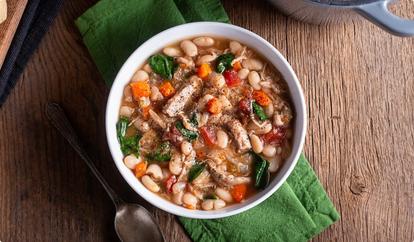The content in this article should not be taken as medical advice. Please consult with your healthcare provider regarding your individual health needs.
When the temperature drops, our cravings for warm, hearty comfort foods rise. It’s that time of year when we all want to indulge in creamy soups, casseroles, and rich desserts. But if you’re keeping an eye on your glucose levels, it can be tricky to enjoy these seasonal favorites without worrying about glucose fluctuations. With a few smart tweaks, like using a glucose biosensor to see how certain foods affect your glucose levels, you can enjoy winter comfort foods that aren’t just delicious but also support your glucose health.
Why do we crave comfort foods in winter?
Winter weather often leaves us craving carb-heavy, rich foods. Our bodies naturally seek warmth and energy, and certain foods can give us that cozy feeling. High-carb, high-fat foods can even trigger the release of feel-good brain chemicals like dopamine and serotonin. The downside is that many traditional comfort foods are packed with refined sugar and unhealthy fats, which can cause blood sugar levels to rise.
Luckily, you don’t have to give up on comfort to stay healthy. Let’s check out some glucose-friendly food alternatives that are healthy and just as comforting.
Glucose-friendly winter comfort foods
Soups and stews: Keep it chunky and veggie-filled
There’s nothing quite like a warm bowl of soup on a chilly day, but be mindful of thick, creamy soups that can be loaded with fats and carbs. Instead, opt for broth-based soups and stews packed with non-starchy veggies like carrots, celery, and spinach. Lean proteins, such as chicken or turkey, are always welcome, and just like that you’ve got a hearty meal that’s easy on your blood sugar.
And don’t sleep on cauliflower. It’s a great low-carb alternative to potatoes or starchy ingredients, and it blends into a creamy, filling base without spiking your blood sugar.
Casseroles: Lighten ‘em up
Traditional casseroles can be loaded with pasta, cheese, and cream sauces, none of which are ideal for glucose health. But with a few simple swaps, they can still be part of your winter menu.
Consider using whole grains like quinoa or farro instead of refined pasta. Both are high in fiber, which helps stabilize blood sugar levels. Another trick? Substitute heavy cream with a light, unsweetened almond milk or a low-fat yogurt to get that creamy texture without all the extra fat.
You can also pack your casseroles with non-starchy vegetables, like zucchini, eggplant, or bell peppers. These veggies add bulk, flavor, and nutrients without the extra carbs.

Chili: Pump up the protein and veggies
A pot of chili is a perfect way to warm up in the winter. Traditional chili, however, can come with a lot of carbs if it includes too many beans or processed meats. Instead, focus on lean proteins like ground turkey or chicken and pile in low-carb vegetables like bell peppers, zucchini, and mushrooms.
Beans are still a good source of fiber and protein, so you don’t have to skip them—just go for smaller portions or mix them with veggies to balance out the carbs. For an extra kick, throw some Greek yogurt or avocado on top instead of sour cream to get healthy fats that help manage glucose levels.
Desserts: Satisfy your sweet tooth mindfully
Who doesn’t want something sweet after a comforting winter meal? The key is finding ways to indulge while still being mindful of your glucose health. Instead of traditional desserts loaded with sugar, try baking with almond flour or coconut flour, which are low-carb alternatives.
You can also swap out refined sugar for natural sweeteners like stevia or monk fruit, which won’t cause blood sugar to spike. Or try a glucose-friendly dessert like a baked apple with cinnamon—it’s naturally sweet, packed with fiber, and perfect for the winter season.
How to manage winter comfort food cravings
It’s completely natural to crave heartier foods in the winter, but keeping your blood sugar at optimum levels is all about balance. If you find yourself reaching for carbs, pair them with a protein or healthy fat. This will help slow down digestion and prevent sudden glucose spikes.
It’s also helpful to be mindful of portion sizes. With rich, comforting foods, it’s easy to overeat. Start with a smaller portion and check in with your hunger levels before going back for seconds.

Comfort and health can go hand-in-hand
You don’t have to give up on winter comfort foods to maintain healthy blood sugar levels. With just a few ingredient swaps and a focus on balance, you can still enjoy all your favorite cozy foods without sacrificing your glucose health.

Curated & reviewed by: Kristyn Milburn
MSN, NP-C, BC-ADM, CDCES
MSN, NP-C, BC-ADM, CDCES
Kristyn Milburn is a dedicated nurse practitioner and diabetes care and education specialist, holding board certification in advanced diabetes management.

